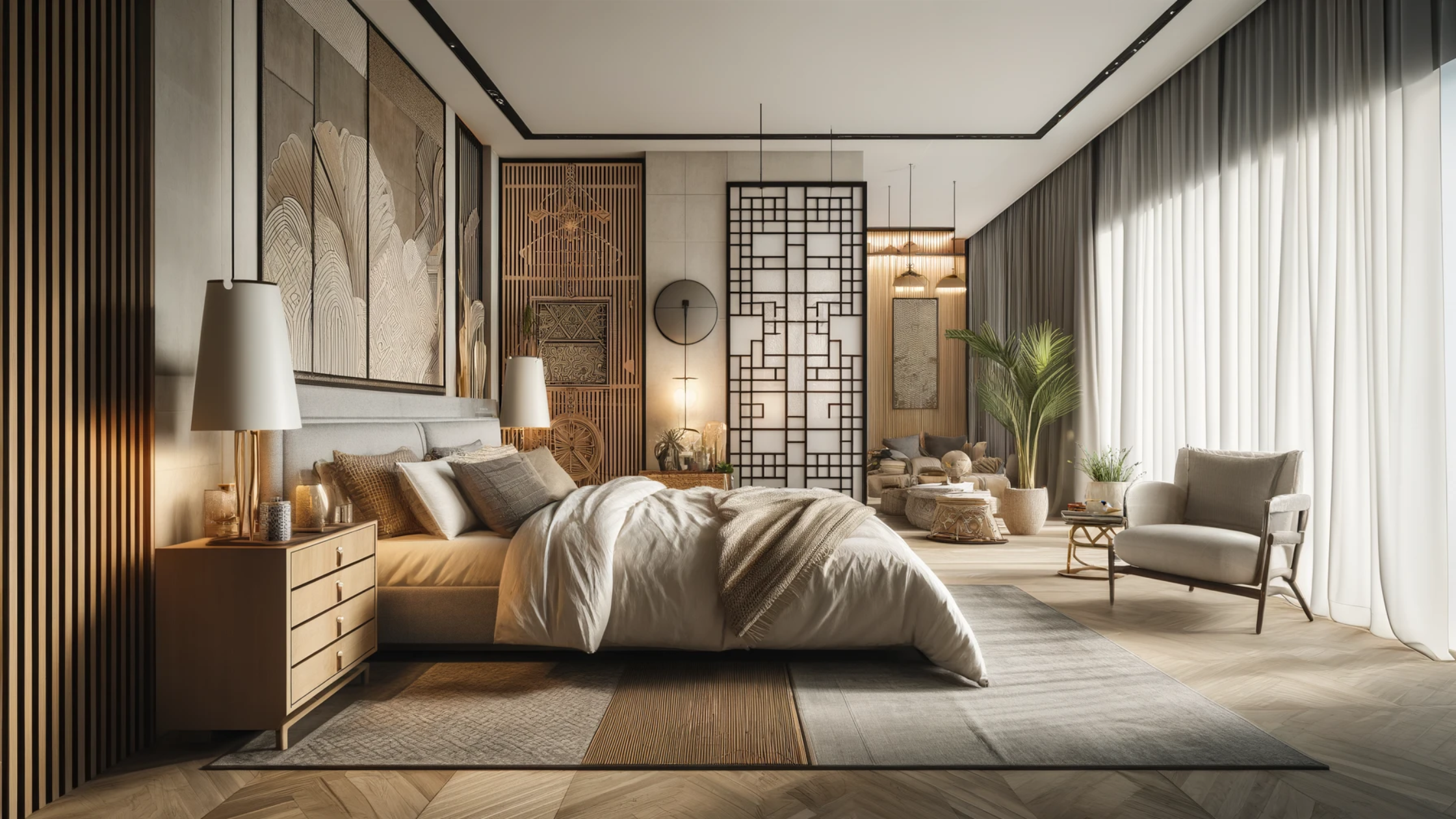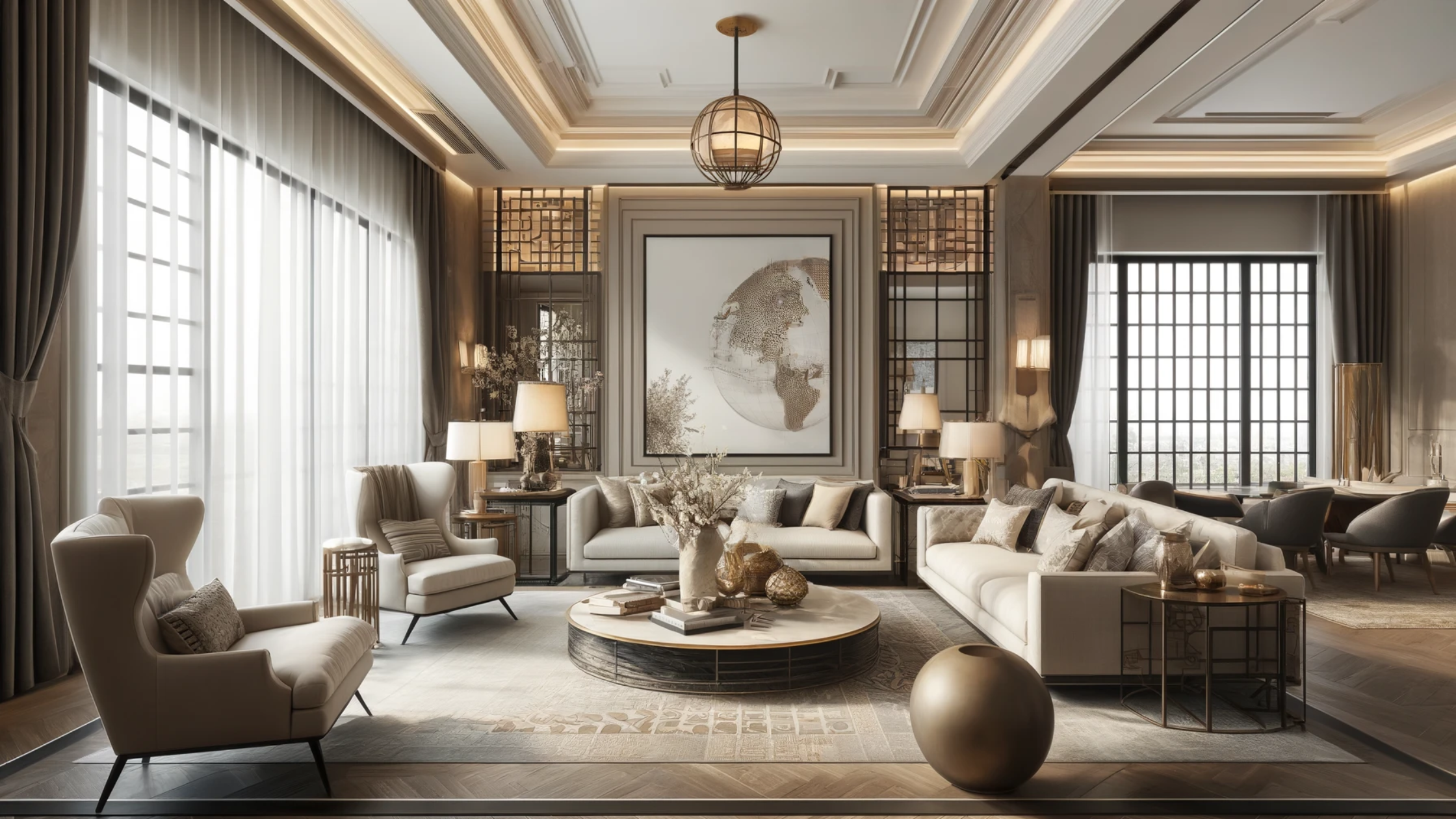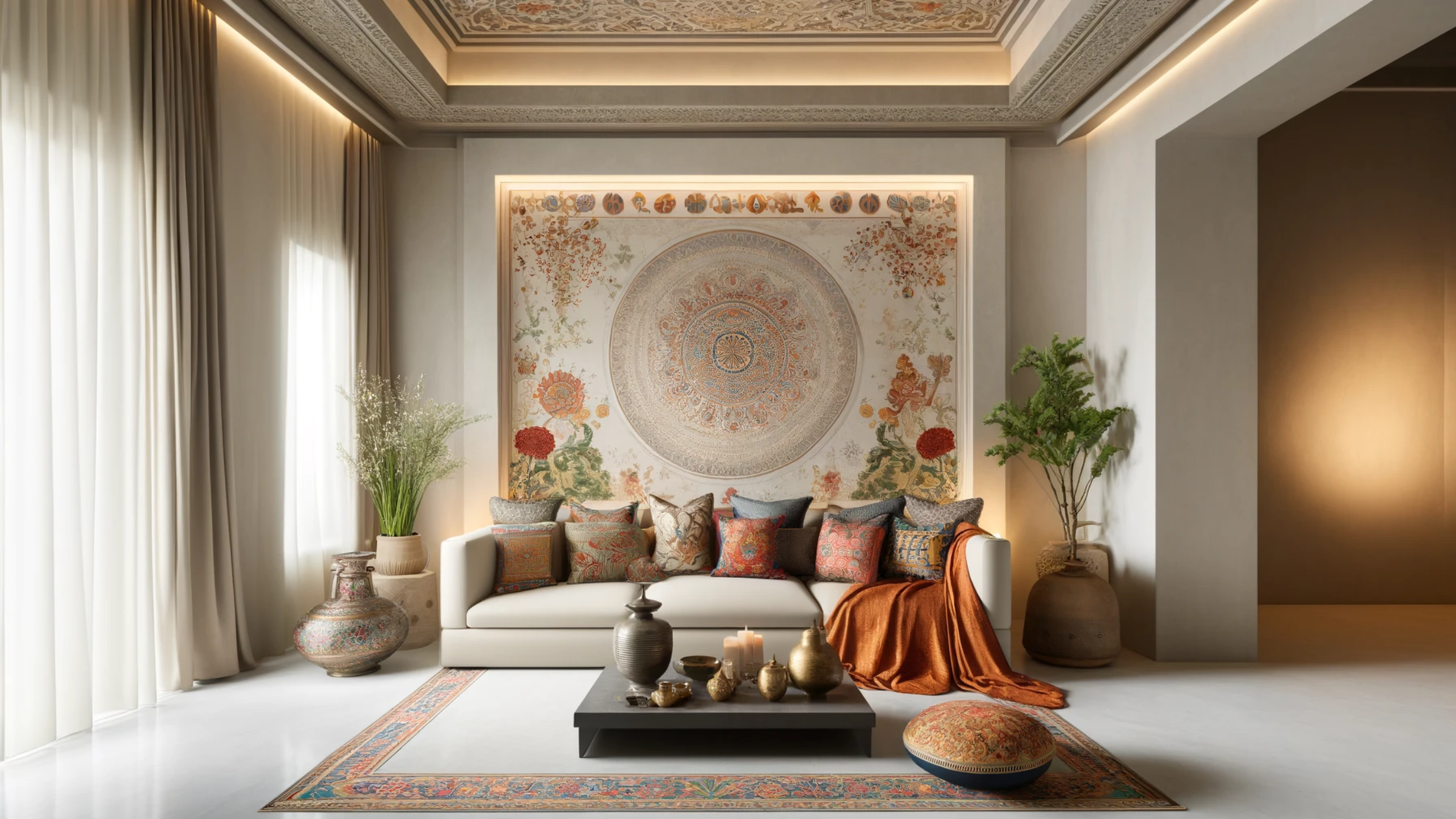
Interior design is an art form that has evolved such that it is indicative of the culture, belief systems and practices that people in a certain region follow. With the era of globalisation, cultures have intermixed to form a diverse array of interior design, especially luxury interior design, which is one of the most popular interior design trends of 2024.

Luxury in Indian Interior Design
Cultural Significance
Historical Roots:
Indian luxury interiors draw inspiration from historical periods such as the Mughal era, the Rajput palaces, and colonial influences, integrating elements like detailed carvings, frescoes, and luxurious textiles.
Craftsmanship:
India is renowned for its artisanal skills in weaving, embroidery, woodworking, and stone carving. Luxury interiors often showcase these handcrafted elements, reflecting the country’s rich artisanal heritage.

Modern Trends in Luxury Interior Design
Contemporary Fusion:
Modern luxury interiors in India incorporate global trends while preserving traditional aesthetics. This fusion creates a distinctive style that is both globally relevant and deeply rooted in Indian culture.
Personalization:
Growing emphasis on personalised spaces that reflect individual tastes and preferences. Custom-made furniture, unique decor pieces, and bespoke designs are increasingly popular in Indian luxury interiors.

Importance of Global Interior Design Influences
Broadening Horizons
Exposure to Global Trends:
The rise of globalisation and digital media has exposed Indian designers and homeowners to international design trends, broadening their horizons and influencing their design preferences.
Diverse Inspirations:
Global influences bring a diverse range of styles, materials, and design philosophies, allowing for a richer and more varied interior design landscape in India.

Fusion of Styles
Eclectic Mix:
Global influences facilitate the fusion of different styles, creating eclectic interiors that blend the best of multiple design traditions. This results in unique and innovative design solutions.
Cultural Exchange:
The exchange of design ideas and techniques between India and other countries promotes a cross-cultural aesthetic, enriching the overall design narrative.

Introduction of New Materials and Technologies
Innovative Materials:
Global influences introduce new and innovative materials, such as sustainable alternatives, high-performance composites, and luxury finishes, enhancing the quality and appeal of interiors.
Advanced Technologies:
Adoption of global technological advancements in interior design, such as smart home systems, energy-efficient solutions, and advanced lighting technologies, elevates the functionality and sophistication of luxury interiors.

Sustainability and Eco-Friendly Practices
Global Awareness:
Increased awareness of global sustainability practices encourages the incorporation of eco-friendly materials and designs in Indian luxury interiors. This includes the use of recycled materials, energy-efficient designs, and sustainable sourcing.
Green Certifications:
Global standards and certifications for green building practices inspire Indian designers to adopt environmentally responsible practices, contributing to sustainable luxury living.

Enhancing Aesthetic Appeal through Luxury Interior Design
Global Aesthetic Standards:
Exposure to global design standards and aesthetics raises the bar for quality and craftsmanship in Indian luxury interiors. This leads to more refined and polished design outcomes.
Innovative Design Solutions:
Global influences introduce innovative design solutions and creative ideas that push the boundaries of traditional interior design, resulting in more dynamic and visually appealing spaces.

Key Global Influences on Indian Luxury Interior Design
Western Influence: Modern, Contemporary, and Classic European Styles
Western influence on Indian luxury interior design is profound, with modern, contemporary, and classic European styles leaving a significant mark. Modern European design is characterised by clean lines, functional layouts, and an emphasis on minimalism. This style promotes the use of neutral colour palettes, sleek furniture, and open spaces, creating interiors that are both sophisticated and comfortable.
Classic European styles like Victorian, Baroque, and Renaissance introduce elements of grandeur and elegance into Indian interiors. These styles are known for their ornate details, luxurious fabrics, and antique furnishings, offering a timeless appeal that resonates with the Indian affinity for opulence and heritage.

Asian Influence: Zen Philosophy, Minimalism, and Feng Shui Principles
Asian influences, particularly from Japan and China, bring a sense of tranquillity and harmony to Indian luxury interior design. Zen philosophy emphasises simplicity, natural materials, and a connection to nature. This translates into interiors that use wood, bamboo, and stone, along with neutral colours and minimalist decor to create serene and balanced spaces.
Japanese minimalism further enhances this aesthetic by focusing on functionality, uncluttered spaces, and the beauty of imperfection, known as wabi-sabi. This approach is increasingly popular in modern Indian homes that seek to reduce visual noise and foster a sense of calm.
Feng Shui principles from China influence the spatial arrangement to enhance the flow of energy (qi) and promote well-being. This involves strategic placement of furniture, use of specific colours, and incorporation of elements like water features and plants to create harmonious environments.

Scandinavian Influence: Hygge, Simplicity, and Functionality
Scandinavian design principles have gained traction in Indian luxury interiors due to their emphasis on simplicity, functionality, and cosiness, encapsulated in the Danish concept of hygge. This style is characterised by a minimalist aesthetic, with a focus on clean lines, neutral tones, and natural materials such as wood and leather. Scandinavian interiors often feature functional furniture that combines form and utility, ensuring that every piece serves a purpose without sacrificing aesthetic appeal.
Simplicity is key, with clutter-free spaces that emphasise natural light and open layouts. The use of soft textiles, warm lighting, and cosy elements like rugs and throws creates a welcoming and comfortable atmosphere. This approach aligns well with modern Indian lifestyles, where there is a growing preference for understated elegance and practical luxury.

Middle Eastern Influence: Rich Textures, Ornate Patterns, and Luxury Materials
Middle Eastern influences bring a sense of exotic opulence and grandeur to Indian luxury interior design. This region is known for its rich textures, including intricate mosaics, plush carpets, and detailed metalwork. Ornate patterns, such as geometric designs, arabesques, and calligraphy, are often used in tiles, textiles, and wall decor, adding depth and visual interest to interiors. Luxury materials like marble, silk, and gold accents are frequently incorporated.
Middle Eastern interiors also emphasise the use of vibrant colours, such as deep blues, rich reds, and sparkling golds, which create a warm and inviting atmosphere. By blending Middle Eastern elements with traditional Indian motifs, designers create luxurious spaces that exude richness, warmth, and cultural depth, making them stand out in the landscape of global interior design.

Integration of Global Interior Design Trends in Indian Interiors
Sustainable Practices: Use of Recycled Materials, Energy-Efficient Designs
The growing global emphasis on sustainability has significantly influenced modern interior design trends in India. Sustainable practices are becoming integral to luxury interiors, reflecting a commitment to environmental responsibility without compromising on style and comfort.
Use of recycled materials is a key trend, with designers incorporating reclaimed wood, recycled glass, and repurposed metal into furniture and decor. This not only reduces waste but also adds unique character to the interiors. For example, reclaimed teak wood can be used to create stunning flooring or bespoke furniture pieces, each with its own history and texture.
Energy-efficient designs are also gaining popularity, driven by advancements in technology and increasing awareness of climate change.

Smart Homes: Integration of IoT and Automated Systems
The advent of smart technology has revolutionised modern interior design, making homes more intuitive, convenient, and luxurious. Integration of IoT (Internet of Things) and automated systems is a major trend in Indian luxury interiors, reflecting a global shift towards connected living. Smart home technologies enable homeowners to control lighting, climate, security, and entertainment systems through their smartphones or voice-activated devices. For example, automated lighting systems can adjust the intensity and colour of lights based on the time of day or the homeowner’s preferences, creating the perfect ambiance for any occasion. Smart thermostats can learn the household’s schedule and adjust the temperature for optimal comfort and energy savings. Home security systems with smart locks, cameras, and motion sensors provide enhanced safety and peace of mind.

Fusion Styles: Combining Traditional Indian Motifs with Global Design Elements
One of the most distinctive trends in Indian luxury interior design is the fusion of traditional Indian motifs with global design elements. This approach creates interiors that are both culturally rich and contemporary, reflecting the best of both worlds.
Traditional Indian motifs such as paisleys, mandalas, and intricate floral patterns are seamlessly integrated into modern designs, often through textiles, wallpaper, and artwork. For example, a modern living room might feature a sleek, minimalist sofa adorned with cushions in vibrant, hand-embroidered silk covers, or a contemporary dining room may include a statement wall with intricate Rajasthani frescoes.
Global design elements like Scandinavian simplicity, Japanese minimalism, or Mediterranean vibrancy are blended with these traditional motifs to create unique and eclectic spaces.

Challenges and Considerations in Adopting Global Interior Design Trends
Cultural Considerations: Ensuring Global Trends Complement Indian Aesthetics
When incorporating global interior design trends into Indian interiors, one of the primary challenges is ensuring that these trends complement and respect traditional Indian aesthetics. Cultural considerations are crucial, as India has a rich and diverse heritage that is deeply embedded in its interior design practices. Indian design is characterised by vibrant colours, intricate patterns, and a strong emphasis on craftsmanship.
Introducing global trends must be done thoughtfully to avoid overshadowing these elements. For instance, while Scandinavian minimalism emphasises simplicity and neutral palettes, it needs to be balanced with the vibrant hues and intricate textiles that are central to Indian design. Designers must carefully curate elements such as colour schemes, fabrics, and decor to create a harmonious blend.

Practical Challenges: Climate Adaptation, Lifestyle Integration
Adopting global interior design trends in India also presents practical challenges related to climate and lifestyle. Climate adaptation is a significant consideration, as India’s diverse climate varies from the tropical south to the temperate north.
Materials and design elements popular in other parts of the world may not always be suitable for the Indian climate. For example, certain types of wood or textiles might warp or deteriorate in the high humidity of coastal regions. Similarly, large glass windows that work well in Scandinavian countries might lead to excessive heat in Indian summers, necessitating additional cooling solutions.
Lifestyle integration is another challenge, as Indian lifestyles often differ significantly from those in Western or other global contexts. Indian homes typically accommodate larger families and frequent gatherings, requiring flexible and multifunctional spaces. Moreover, kitchen designs must accommodate traditional cooking practices, which involve high heat and extensive use of spices, affecting ventilation and material choices.

Financial Aspects: Costs of Luxury Materials, Designer Services
Financial considerations are another critical factor when adopting global interior design trends in Indian interiors. Costs of luxury materials and designer services can be substantially higher when incorporating global influences. Imported materials, such as Italian marble, German fixtures, or Scandinavian furniture, often come with hefty price tags due to shipping, taxes, and duties. This can significantly increase the overall budget of a design project.
Additionally, hiring designers who specialize in global trends or possess international experience can be expensive. These professionals bring a wealth of knowledge and expertise. Balancing cost with quality and aesthetics is a key challenge for homeowners and designers alike.

The blend of global and local elements in luxury Indian interiors creates a unique and sophisticated aesthetic that marries traditional Indian richness with contemporary global trends. This fusion results in interiors that are culturally rich, yet modern and innovative.
Visit our website to know more about integrating luxurious modern interior design within your homes to create an artistic and welcoming look.
Frequently Asked Questions (FAQs)
How do global influences impact luxury interior design trends in India?
- Global influences play a significant role in shaping luxury interior design trends in India by introducing new design concepts, materials, and aesthetics from around the world.
- These influences inspire Indian designers and homeowners to embrace modern styles, innovative technologies, and sustainable practices, resulting in interiors that are both globally relevant and culturally resonant.
What are some notable global design trends influencing luxury interiors in India?
- Some notable global design trends influencing luxury interiors in India include the integration of sustainable practices such as the use of recycled materials and energy-efficient designs, the adoption of smart home technologies like IoT and automated systems, and the fusion of diverse design styles from different parts of the world.
- These trends reflect a growing awareness of environmental responsibility, technological advancements, and a desire for unique and personalised living spaces.
How are traditional Indian elements incorporated into modern luxury interiors influenced by global trends?
- Traditional Indian elements such as intricate patterns, vibrant colours, and handcrafted textiles are seamlessly integrated into modern luxury interiors influenced by global trends.
- Designers often blend traditional motifs with contemporary design styles such as Scandinavian minimalism or Japanese Zen principles to create a unique fusion that respects India’s rich cultural heritage while embracing the sophistication and functionality of global design trends.
What are the challenges in adopting global design trends in Indian luxury interiors?
- Some challenges in adopting global design trends in Indian luxury interiors include ensuring that these trends complement Indian aesthetics, adapting to the country’s diverse climate and lifestyle, and managing the financial aspects associated with luxury materials and designer services.
- Designers must carefully balance global influences with local sensibilities to create spaces that are culturally authentic, practical, and financially feasible.
How do global influences contribute to the future of luxury interior design in India?
- Global influences contribute to the future of luxury interior design in India by fostering creativity, innovation, and sustainability.
- As India becomes increasingly integrated into the global market, the exchange of design ideas and technologies will continue to enrich the design landscape, offering homeowners a diverse range of options to create luxurious and stylish living spaces that reflect their individual tastes and preferences.
Recent Posts
- Luxury Kitchens: The Perfect Balance of Aesthetics and Functionality
- Feature Walls: Adding Character to Your Interiors
- A Guide for Creating Cosy Interiors
- Ensuring Sustainability While Maintaining Luxury in Interior Design
- From Quartz to Velvet: A Guide to Interior Design Accessories and Exquisite Finishes
Recent Comments
Tags Cloud
Categories
- Architecture 28
- Experiences 7
- Home style 37
- Inspirations 13
- Interior 38
- Modern 28
- Others 3
- Reviews 3
- Tips 4
- Uncategorized 1
Search
CATEGORIES
- Architecture 28
- Experiences 7
- Home style 37
- Inspirations 13
- Interior 38
- Modern 28
- Others 3
- Reviews 3
- Tips 4
- Uncategorized 1










